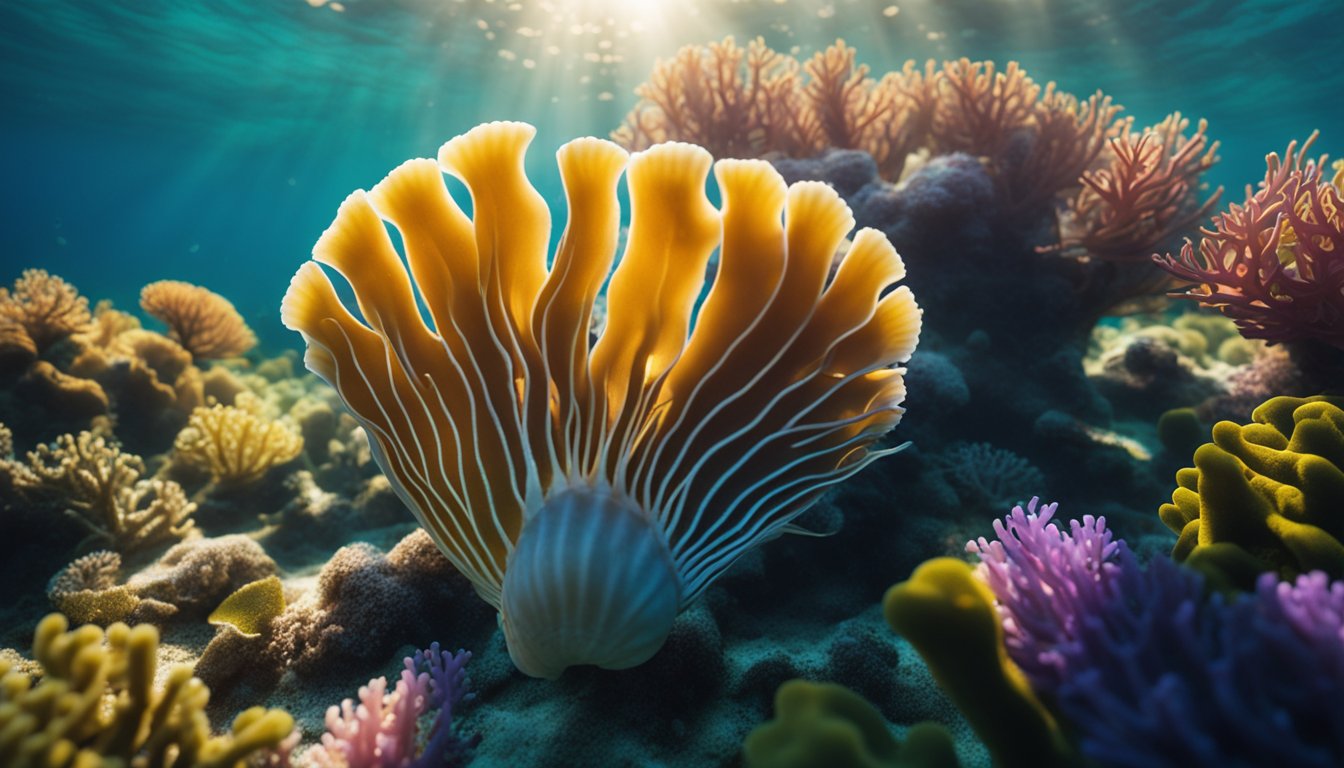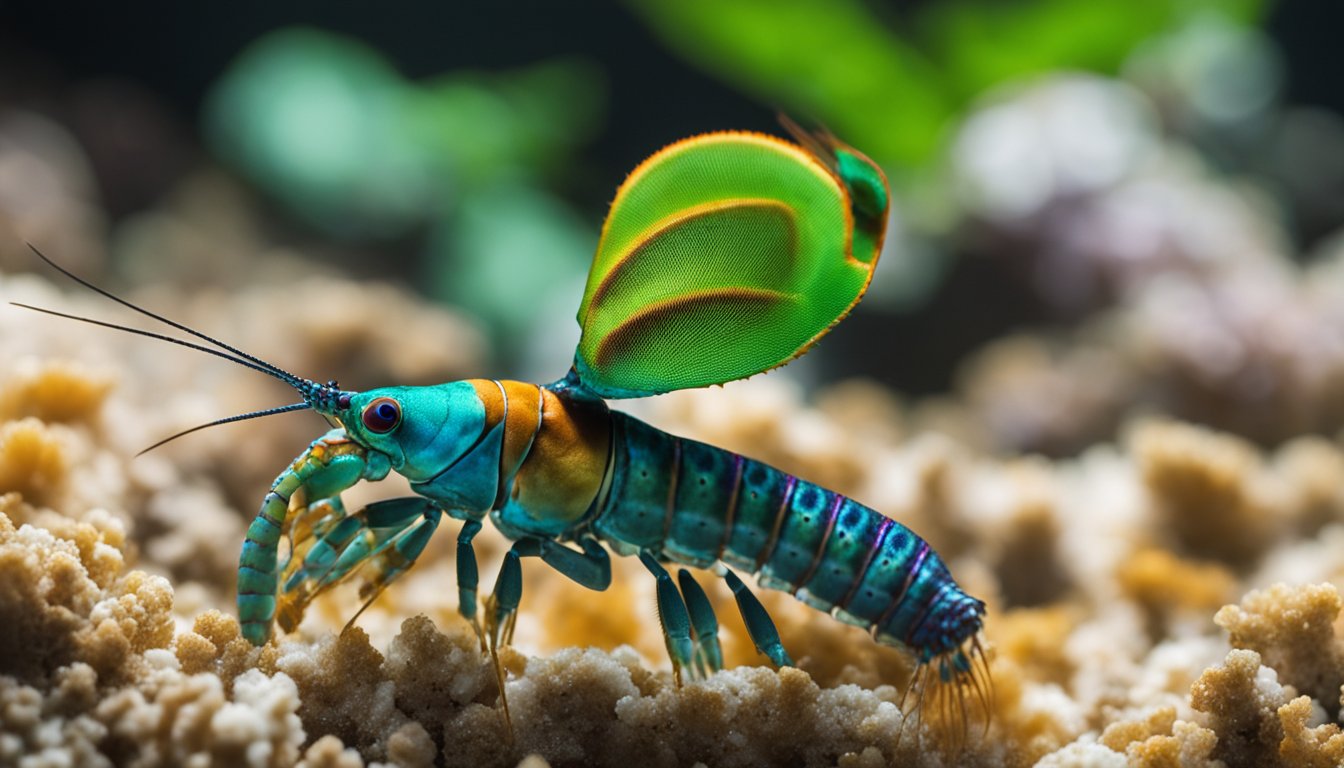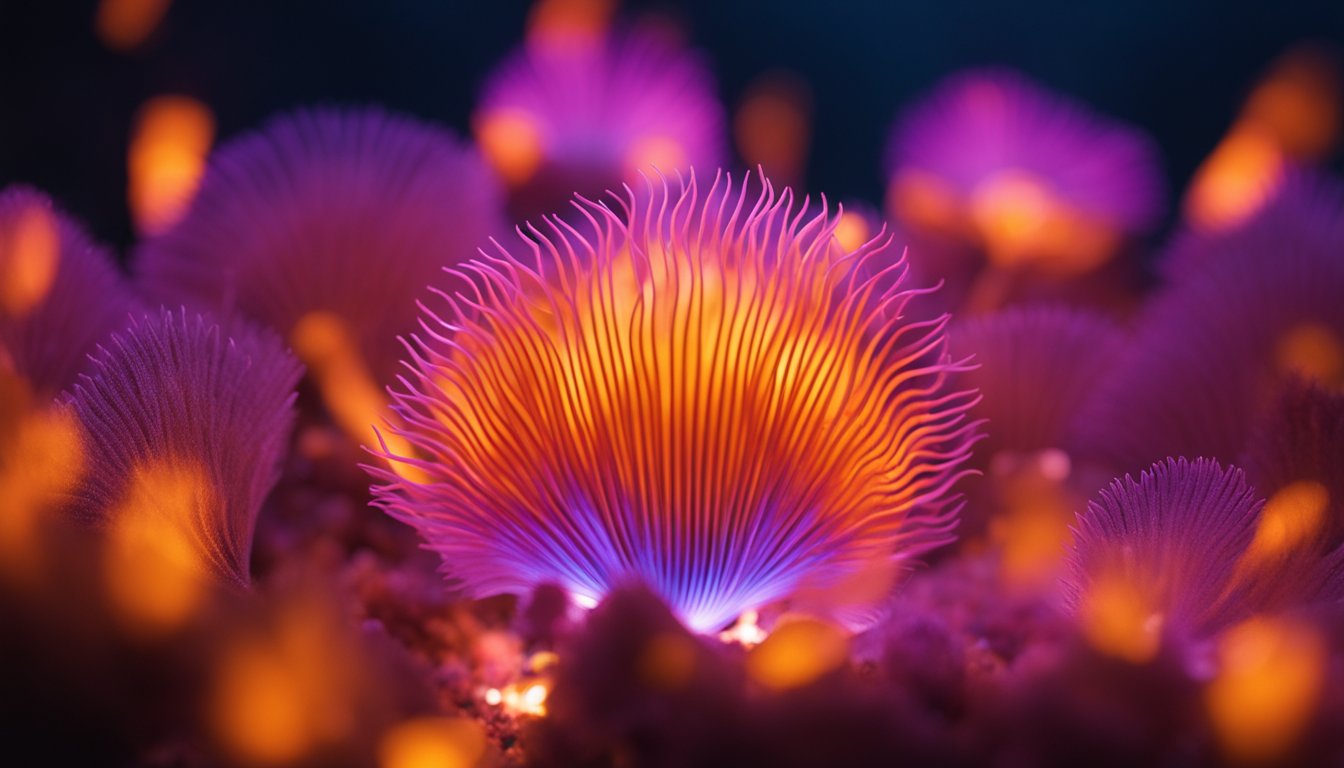Imagine being a treasure hunter, combing through the sandy ocean floor.
Instead of gold coins or glittering jewels, our prize is the Lion’s Paw Scallop, a remarkable creature of the sea.
Its scientific name is Nodipecten subnodosus, but we’ll just call it the Lion’s Paw.
With its fan-shaped shell and vibrant colors, it’s not only beautiful to look at but also plays an important role in ocean habitats.

This scallop’s shell is a sight to behold, usually sporting a mix of bold orange and red hues, sometimes with a dash of purple.
These colors make it stand out in the underwater world like a precious gem.
Each side of its shell has rippling ridges just like a lion’s paw, hence the name.
The Lion’s Paw Scallop can be found hiding in the seagrass or buried in the sand, mostly in the warm waters of the Western Atlantic Ocean.
But why should we care about this ocean treasure? Well, scallops, including the Lion’s Paw, are more than just pretty sea-dwellers.
They are a key species in their ecosystem. By filtering water to feed, they help keep our oceans clean.
Plus, they’re a favorite snack for creatures like starfish and crabs.
As we explore the Lion’s Paw Scallop’s world, we discover the delicate balance of life under the waves and how every creature, no matter how small, has a big part to play.
Discovering the Lion’s Paw Scallop

When we explore the ocean’s treasures, the Lion’s Paw Scallop stands out with its striking appearance and unique dwelling places.
Through our eyes, let’s learn what makes them so special!
Distinctive Features
Let’s picture the Lion’s Paw Scallop.
It’s as though it has donned a royal cloak made of the brightest colors nature can offer, isn’t it?
Their shells boast a rich, deep red or orange color with bold patterns that resemble the alluring mane of a lion.
The shells are truly magnificent and can grow to be quite large, up to 6 inches across!
The inside of their shell is usually smooth and shiny, making it appear as if it was painted by the ocean itself.
Habitat and Range
Our friend the Lion’s Paw Scallop prefers to make its home in the warm, cozy waters along the sandy or muddy bottoms of the ocean.
They are most commonly found hanging out in the Western Atlantic Ocean, from the Carolinas in the United States, all the way down to Brazil.
They’re not the type to stay in shallow pools; oh no, they are adventurers, preferring depths of up to 100 feet!
Imagine swimming that far down, with the sunlight becoming a distant glow above, finally greeting these natural gems of the sea.
The Role in the Ecosystem

Within the vibrant underwater world, The Lion’s Paw Scallop plays a crucial part in maintaining the ecological balance.
We’re about to explore how this colorful creature both contributes to its environment and relies on it.
Diet and Predators
Did you know that we, the Lion’s Paw Scallop, are filter feeders? Yes, that’s right!
We feast on tiny particles floating in the ocean, such as plankton, by filtering water through our gills.
We’re like the ocean’s little vacuum cleaners, keeping the water clean for everyone.
But life underwater isn’t just about what we eat; it’s also about who might be eyeing us for their next meal.
Our main predators include starfish, crabs, and some fish. They love to try and pry our shells open for a tasty snack.
Though, we’re not easy to catch thanks to our strong shell muscles that snap shut, keeping us safe.
Symbiotic Relationships
Imagine having a roommate that cleans the house, prepares your food, and looks after you. Well, we have something similar with our algae friends!
The algae live on our shells and convert sunlight into food through photosynthesis, which we then use.
This partnership helps us both survive and thrive in our underwater neighborhood.
And guess what? We also have other buddy-creatures called ‘commensal organisms’.
They hang out with us because our shells provide them a safe home away from predators.
While they don’t help us out directly like the algae, having them around doesn’t hurt us either.
It’s like having friendly neighbors in our ocean community!
Human Connections

Our Lion’s Paw Scallop isn’t just a lovely sea creature to admire, folks—it’s intertwined with our lives in fascinating ways!
Let’s plunge into how we appreciate this ocean gem on our plates and work to ensure its future splashes.
Culinary Uses
We definitely love to savor the delicate taste of the Lion’s Paw Scallop.
Chefs often serve it seared with a golden crust, yet tender and briny inside—a culinary masterpiece!
Imagine it on a plate, looking like little round nuggets of the ocean, bursting with flavors that remind us of salty waves and fresh sea breeze.
Renowned for its larger-than-average size, our scallop has meat that’s rich and satisfying.
In fancy restaurants, you can find it thoughtfully paired with light pasta, zesty lemon, and herbs.
But it’s not just for fancy meals; we can also enjoy it grilled at a beach barbecue, bringing a touch of luxury to our picnic tables.
Conservation Efforts
As much as we love eating them, we also recognize the need to look after these beautiful bivalves.
Conservation groups are conducting research to understand better how we can make sure Lion’s Paw Scallops stick around for generations to come.
Did you know that some areas where our scallop friends live are protected to help their populations grow?
Researchers and volunteers work tirelessly to monitor their habitats and the impact of our actions on their lives.
Sustainable fishing practices are being put in place, helping us enjoy our seafood without depleting the ocean’s bounty.
By choosing scallops from sustainable sources, we’re making a big splash in the health of the marine world!
Life Cycle of the Scallop

Scallops are spectacular ocean dwellers, and understanding their life cycle brings us closer to the wonders of marine life.
Let’s take a peek into the stages of growth and how they reproduce to keep the ocean floor twinkling with their presence.
Growth Stages
From the moment scallops hatch, they embark on a fascinating journey of growth.
Like a tiny speck of magic, a baby scallop, called a spat, starts off no bigger than a grain of sand.
These spats cling to a surface with their byssal threads, growing steadily in their juvenile stage.
Within their first year, they can reach a size of about 30 millimeters.
Isn’t it amazing how they begin to show off their iconic shell shape and develop the ability to swim by flapping their shells?
This swimming ability is not just for fun; it helps them escape hungry predators!
As they progress into adulthood, scallops continue to grow by adding new layers to their shells.
They do this with the help of a part of their body called the mantle.
The mantle secretes calcium carbonate, which hardens into the beautiful, protective houses we see on the beach.
It takes about four to five years for them to reach their full size, which can be about six inches across.
Imagine holding a dinner plate-sized living treasure in your hands!
Reproduction
When the warm seasons roll in, scallops are ready to reproduce, and it’s a crucial time for them.
They can release millions of eggs and sperm into the water, but here’s the twist: scallops are hermaphrodites, meaning they have both male and female reproductive organs.
How convenient is that?
Fertilization takes place freely in the ocean waters, and this leads to the next generation of spat.
This reproductive strategy is quite efficient as it increases the chances of scallop babies surviving in the unpredictable ocean.
Did you know that just a small number of these released eggs will become adult scallops?
It’s a big ocean out there, and the journey from egg to adult is filled with challenges.
But those who make it continue the cycle, ensuring that we can marvel at these ocean treasures for years to come.
Isn’t the life cycle of the scallop just as dazzling as the shells they create?
Keep your eyes peeled on your next beach visit; you might just find a lion’s paw scallop looking back at you!
Scientific Research
When we explore the world of the Lion’s Paw Scallop, we dive into a sea of intriguing discoveries and innovative study methods.
Let’s put on our scientist hats and peer through the microscope together!
Study Techniques
We’ve got some pretty cool tools in our research toolbox!
Just like detectives, we use things called genetic markers to figure out how these scallops are related to each other.
It’s like looking at a family tree under the sea!
🌊 We also track how they grow by measuring their shells with calipers—kind of like a ruler that can hug the curves of the shell.
And sometimes, we even use satellites to see where they hang out—it’s like checking in on a friend using a spaceship! 🛰️
Recent Discoveries
Guess what? We found out some amazing things lately. Our Lion’s Paw friends like to throw a party.
But instead of music and cake, they release a ton of eggs and sperm into the water to meet up and create baby scallops.
This happens in a huge event called spawning.
And we’ve identified some places where they love to do this the most, turning them into underwater nurseries!
🐚 Plus, we’ve discovered some scallops have a superpower against pollution—they’re a bit like our ocean buddies with capes that help keep the water clean.
How cool is that? 🌟
Frequently Asked Questions
We’re excited to share some intriguing aspects of the Lion’s Paw Scallop with curious minds like ours.
Let’s dive into some fun questions that spotlight this oceanic gem’s unique qualities.
What fabulous feature makes the Lion’s Paw Scallop stand out from other sea critters?
The Lion’s Paw Scallop boasts a spectacular shell that dazzles us with its deep ridges and plump shape.
It’s like the star of the sea with its striking appearance, looking very much like a lion’s paw, hence the name.
Its shell can grow quite large, making it one of the most eye-catching treasures on the seafloor.
How does the Lion’s Paw Scallop play hide and seek on the ocean floor?
This clever bivalve hides by burrowing into the sandy or muddy ocean floor.
We can imagine it saying “you can’t see me!” as it uses its strong foot to scoop itself under the surface.
This camouflage game not only keeps it hidden from predators but also turns it into a sneaky surprise for passing divers and snorkelers.
If a Lion’s Paw Scallop were going to a party, what colorful outfit would it wear?
Decked out in its best, a Lion’s Paw Scallop would be the life of any ocean party!
Its shell is like a natural ball gown, with hues ranging from sunrise orange to sunset red, and sometimes it has a splash of purple or yellow.
It’s definitely not shy about showing off its colors.
What’s the deal with the Lion’s Paw Scallop’s house, and how does it keep safe from nosy neighbors?
Our friend the Lion’s Paw Scallop lives in a sturdy shell made of two hinged parts called ‘valves.’ These valves snap shut tight when danger lurks, keeping the scallop safe inside like a cozy fortress.
This not only protects its soft insides but also turns away unwanted visitors with a ‘no vacancy’ sign.
Can you believe the Lion’s Paw Scallop is super strong? How does it flex its muscles?
Yes, indeed, this scallop is surprisingly buff! It uses a mighty muscle called the ‘adductor’ to snap its shell closed.
Whether it’s evading a threat or just doing its daily workout, the Lion’s Paw Scallop’s muscle power is seriously impressive.
It’s like the bodybuilder of the ocean floor.
Are Lion’s Paw Scallops the social butterflies of the ocean, and who are their best buddies?
While not exactly the chatty types, Lion’s Paw Scallops do enjoy the company of their fellow sea creatures.
They’re often found in groups, which makes us think they like to stick together like pals at a playground.
They share their sandy homes with friends like crabs, starfish, and sometimes even small fish that seek shelter among their shells.




